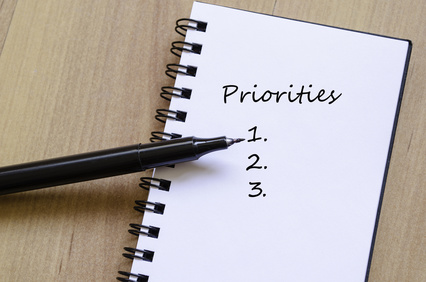
When I recently surveyed my audience to determine specific areas that their students struggle in, one of the most common responses was the difficulty that students had in setting priorities.
Some specific responses from educators included the following:
- How to recognize a patient is deteriorating (priority) and what actions can be implemented to prevent further deterioration
- What should the student do next? (NOT just do the next thing, but what is the next priority?)
- How to set priorities. What is the worst thing that could happen with this patient/how are you going to prevent that?
Because of clinical inexperience, novice nursing students struggle to establish and identify priorities in the clinical setting (Benner, 1982). Though there is no substitute for clinical experience to develop this nurse thinking skill, there are principles of priority setting that can be utilized to provide guidance and structure to see this ability strengthened while a student.
The ability to consistently set correct priorities will be made much more difficult after students graduate. No longer will students have 1-2 patients, but 4-6 patients in acute care and double this in transition or skilled care settings.
Priority Setting & the NCLEX®
The ability to recognize and establish correct priorities is also a skill that the NCLEX® measures in the Client Need category Management of Care which is also the highest weighted NCLEX® category (16-22%). When principles of priority setting are understood and incorporated into student’s practice it has the dual benefit to prepare them for the NCLEX®, but more importantly years of professional practice.
Priority Setting Defined
Setting priorities is determined by differentiating between problems that need immediate attention and problems that can wait (Alfaro-LeFevre, 2013). Patient outcomes will ultimately be impacted if the nurse is unable to recognize the current priority and intervene.
Failure to recognize the current priority can delay needed intervention that can result in an adverse outcome. That is why it is imperative that students grow in the ability to set correct priorities and accomplish the most important interventions first.
Nursing Priority
One practical strategy to teach priority setting is as simple as the ABC’s! The ABC’s of priority setting are always relevant and must remain in this order. If a patient has either a primary problem that directly relates to airway, breathing, or circulatory priorities, or has nursing interventions that represent the ABC’s, set priorities in the sequence of alphabetical order! This is also an NCLEX® approach to priority setting as well.
For example, if one of your patients needs a prn for pain medications, another patient requires an IV bolus of 0.9% NS for dehydration, the ABC’s of priority setting will dictate that the C-circulatory priority of volume resuscitation needs to be done FIRST, then the non ABC priority of pain medication done second.
Lessons from the Battlefield (& ED!)
To help students understand the essence of priority setting, there is one word that is foundational to emergency care – TRIAGE. Triage is the process of sorting through the medical needs of patients to determine which patient has priority based on the severity of their condition.
Triage was originally performed on the battlefield with mass casualties. Doctors and nurses determined which wounded warriors could be saved and would be seen first, who was likely to die and would receive no treatment, and who had minor wounds and could wait for treatment with no adverse outcome.
Clinical Reasoning Needed to Set Proper Priorities
Practical priority setting in the clinical setting using the principle of triage depends on the nurse’s ability to recognize which patient concern/task needs immediate attention, what interventions need to be done FIRST, and what can wait. This requires experience, but proper priority setting is also a key component of clinical reasoning.
In order to recognize which patient is your highest priority with multiple patient assignments,students must be able to use one key aspect of clinical reasoning: RECOGNIZE the RELEVANCE or significance of clinical data that is in the chart or collected by the nurse that may represent a clinical problem. (See my past blog on clinical reasoning)
If relevant clinical data is not recognized or acted upon, the priority patient is not recognized. This can contribute to a delay of care for a patient who may have a critical concern.
Priority Patient
Because students will consistently have multiple patients after graduation, begin to prepare them NOW, to recognize the priority patient regardless of the clinical setting. The following principles will guide the development of this essential nurse thinking skill.
- How old is the patient?
- The older the patient, the higher risk they are to develop complications. Therefore, if all considerations are equal, see the oldest patient FIRST.
- When were they admitted?
- The more recent the day of admission, the more likely the patient is higher acuity and at risk for a change of status. Therefore, if all considerations are equal, see the most recently admitted patient FIRST.
- When did they have surgery?
- The more recent the day of surgery, the higher the acuity and risk for a change of status. Therefore, if all considerations are equal, see the most recent surgical patient FIRST.
- How many body systems are involved?
- Chronic renal failure patients are an excellent example of patients who typically have multiple body system derangements because of systemic metabolic changes influenced by renal disease. If medical complexity is present and all other considerations are equal, this patient should be seen FIRST.
Listen to your Gut!
Don’t forget to emphasize the importance of paying attention to your gut! This important principle of priority setting must not be minimized when your gut instinct tells you something is not quite right with your patient.
Though you may not be able to put your finger on the specific problem, you must pay close attention to this feeling and investigate and assess further to delineate your concern.
Even if you are not able to identify a concrete assessment finding that confirms your feeling, there is a reason you are feeling what you are experiencing and it likely represents a potential problem.
In Closing
Integrate these principles of priority setting in your clinical setting to strengthen the ability of your students to set priorities and think like a nurse!
Priority setting is an essential component of clinical reasoning. Therefore, if clinical reasoning is deeply understood so it can be applied to the bedside, your students will have a foundation laid to be safe as they develop the ability to think more like a nurse by integrating these principles of priority setting in their practice!
References
Alfaro-LeFevre, R. (2013). Critical thinking, clinical reasoning, and clinical judgment: A practical approach. (5th ed.). St. Louis, MO: Elsevier–Saunders.
Benner, P. (1982). From novice to expert. American Journal of Nursing, 82(3), 402–407.
Keith Rischer – Ph.D., RN, CCRN, CEN
As a nurse with over 35 years of experience who remained in practice as an educator, I’ve witnessed the gap between how nursing is taught and how it is practiced, and I decided to do something about it! Read more…
The Ultimate Solution to Develop Clinical Judgment Skills
KeithRN’s Think Like a Nurse Membership
Access exclusive active learning resources for faculty and students, including KeithRN Case Studies, making it your go-to resource.



